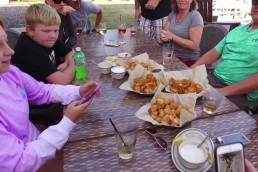September Walleyes Crush Plastic Baits
SHARE THIS POST
The summer months brought us walleyes, including using bottom-bouncers, crankbaits and the mechanical fishing systems of rod holders, with anglers sitting and standing idly by waiting for a bite. But September brings hands-on walleye fishing and new patterns. They start schooling up and move into the shallows, seeking surviving green weeds left over from the summer’s burned-out vegetation.
The walleyes are now swimming to areas full of minnows, cover and oxygen, unlike the dead weed beds they have just vacated that are now consuming oxygen.
I use my Humminbird Helix Series for its side-imaging sonar capabilities to view weed beds and rock piles from a distance without motoring over the potential areas and disturbing fish. Weed pockets, rock crowns, points and sunken logs are the structure I’m looking for. I like dropping my waypoints far from the location I wish to fish—it’s like playing virtual long toss with marker buoys without strange boats interloping on a spot. Use LakeMaster with the sonar to target areas faster. The map cards can highlight locations in color and uses high definition, allowing anglers to see a lake’s contours easier to help find more fish. Walleyes this season will also move to the top of structure with steep breaks and saddles, so refining your search capabilities is key.
September will see highs in 70s early then the 60s will eventually dominate as the highs, triggering greater fish activity. This is why autumn is one of my favorite times to guide walleyes—not only are these fish more active, but you also have a better chance for a true trophy. In my 23-plus years of guiding during this month, we have caught many fish in the 8- to 10-pound range.
Angling now can be simplified, and using a Roach Rig, which is a sinker, a swivel, 6 to 8 feet of monofilament or fluorocarbon leader, a Rock-Runner Slip Bouncer (a sinker with a wire through it designed to tiptoe through areas with snags) and a long, snelled, live bait hook with or without a single bead will suffice.
Live-bait rigging big redtails, creek chubs, large shiners or even sucker minnows is a popular walleye producer now. Jigging with a minnow or a jig and plastic combination can also get numbers of walleyes, as well as larger ones. Northland’s Impulse soft plastics allow you to rip jig through the weeds or bounce off the rocks, creating angry strikes. Jigging with shiners work, but weeds and rocks can wreck the bodies of the minnows. Plastics are simply awesome in situations that require aggressive motions to trigger fish. The plastic minnow body is soft, but doesn’t rip off the hook like a minnow does. Often, one plastic body can outlast many fish and a number of strikes. I use lots of shapes, but my go-to plastic is an Impulse Smelt Minnow or Paddle Minnow. These are scented plastics that resemble a shiner or a young-of-the-year perch, or even smelt. There are many different colors available, and remember, different lakes have fish with different color preferences that are based on that particular body of water’s color and clarity.
Are you enjoying this post?
You can be among the first to get the latest info on where to go, what to use and how to use it!
Use paddle tails if you’re looking for a slow fall with lots of action. A paddle tail has a t-shaped tail that wags as it’s pulled through the water, even when it’s sinking to the bottom or trolled behind a boat. I use ones with a little barb on the collar that keeps the plastic tails from slipping off. For the weight, use 1/8 to 1/4 ounce, depending on the depth. Pitch them into shallow areas less than 6 feet, and use 1/8 ounce. If I’m pitching in depths more than 6 feet, I will use 1/4 ounce. Sometimes anglers want the jig and plastic to sink faster to trigger strikes. But most of the time walleyes are holding tight to the structure or are cruising the weedlines.
Traditionally, jigging cadences can be a “lift and fall,” but throw in more “sweeps” and “rips” when using the plastics. A strike can occur on the fall, so the next jig stroke after these cadences may set the hook.
I will use a St. Croix Legend Tournament Series Rod at 6 feet 3 inches or a 6-foot-6 rod in an extra- fast, medium action—it provides the right balance for finessing and ripping jigs and plastics.
Many lakes get more walleyes in the morning and evening, but in September, the action can go all day, making fall a favorite time target this species.
Brian “Bro” Brosdahl is a nationally known fishing guide and lead spokesman for many of the top companies in ice fishing. He can be contacted at bbro@paulbunyan.net or through his website at brosguideservice.com. Follow him on Instagram, Twitter and Facebook.
MWO
SHARE THIS POST
Did you enjoy this post?
You can be among the first to get the latest info on where to go, what to use and how to use it!
Brian 'Bro' Brosdahl
Outdoor communicator Brian “Bro” Brosdahl lives in northern Minnesota. He is a walleye guide in the Cass Lake, Leech Lake and Lake Winnibigoshish areas. He is sponsored by Northland Fishing Tackle, Frabill/Plano, Aqua-Vu, Humminbird/Minn Kota, St. Croix Rods, Ranger Boats, and Evinrude. Guide inquiries: brosguideservice.com. Follow on social media.



